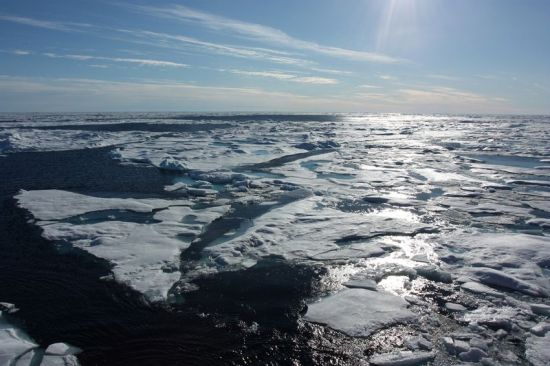Huge Dome of Freshwater Growing in the Arctic Ocean
A bulge of freshwater in the Arctic Ocean measuring in at around 8,000 cubic kilometers in size discovered back in 2002, was recently discovered to have risen about 15 centimeters since its discovery. Lead author of the study, Dr. Katharine Giles from the Center for the Polar Observation and Modeling and her team of U.K. scientists, who made the discovery using radar satellites belonging to the European Space Agency, feel the dome of freshwater is rising due to strong winds causing a clockwise current in region.
Dr. Giles explains, “In the western Arctic, the Beaufort Gyre is driven by a permanent anti-cyclonic wind circulation. It drives the water, forcing it to pile up in the centre of gyre, and this domes the sea surface,” and states that the team’s data shows the trend is “biggest in the center of the gyre and less around the edges.” Since the discovery of the bulge in 2002, the teams’ data suggests the bulge has been swelling around 2 centimeters per year.
This bulge isn’t the only instance of freshwater int he Arctic Ocean, but it doesn’t count for around 10% of the total freshwater found in the Arctic — a region that isn’t exactly tiny. Why, exactly, does it matter that there’s a large bulge of freshwater in the Arctic, or freshwater separate of the bulge? If freshwater — from the bulge being released, or from anywhere else — began entering the North Atlantic in large volumes, it could affect the currents that have control over European weather patterns.
The team suggests that the freshwater bulge could’ve been caused by a change in the relationship between wind and ocean caused by the rapid decline of sea ice cover, which could cause greater mixing of the layers in the Arctic Ocean. Greater mixing of layers is notable because it could cause warm water from deeper in the ocean to well up, which in turn could cause sea ice loss to happen at a quicker rate, which in turn could affect the relationship between wind and ocean, which is what the team feels created the freshwater bulge. Everything comes full circle.
The team is now taking on the task of measuring the likelihood of this cycle beginning.
(via BBC News)
- Who owns the Arctic? It’s messy
- Wondering why this winter isn’t very cold?
- Overkill making popcorn with Arctic Lasers
Have a tip we should know? tips@themarysue.com
